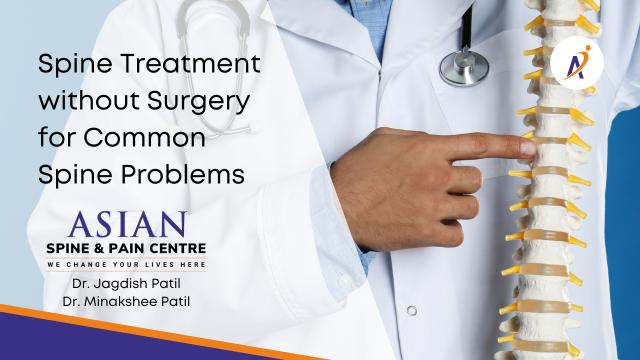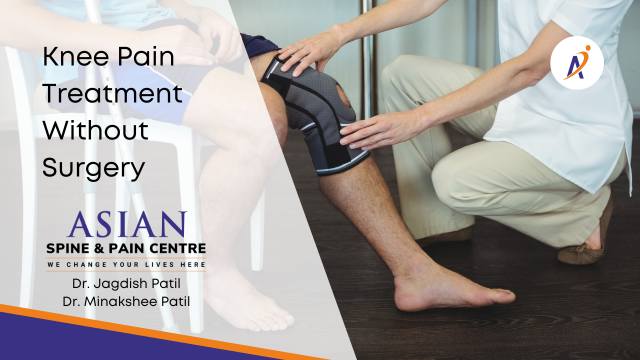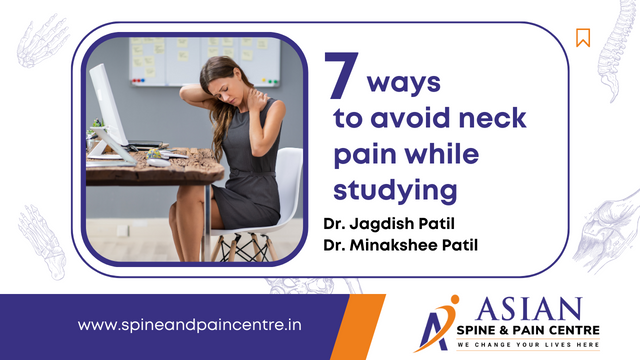Dr. Jagdish Patil & Dr. Minakshee Patil provides spine treatment without Surgery for common spine problems like spinal stenosis, herniated disc, sciatica, arthritis in Pune.
Spine Treatment without Surgery for Common Spine Problems

Nowadays spine problems are very common due to sedentary lifestyle. Everyday we get patients with back pain & neck pain. In many cases, patients wait till pain is unbearable or they get difficulty in walking due to pain. Back pain or neck pain due to Spine problem can be treated without surgery as well. At Asian Spine & Pain Centre, Dr. Jagdish Patil provides spine treatment without surgery in Pune.
What are the common spine problems?
Herniated Disc:
The spine is made up of bones called vertebrae. Discs act as cushions between each bone. When a disc becomes herniated, that means the cushioning has shifted and is bursting out of its casing. Herniated discs lead to back pain, neck pain, tingling etc. as they interfere with nerves in the spine.
Cervical Spondylosis:
It is caused by the gradual degeneration as you age. There is a chance of a slipped disk there, or the vertebrae may sprout extra bone called spurs to try to increase strength. The ligaments that link the vertebrae might stiffen and tighten over time. Whatever the cause, your neck may hurt or be difficult to move. If disks or vertebrae press heavily on nerves and nerve roots, irreversible injury may result.
Osteoarthritis:
Arthritis, which is the inflammation of the joints, can affect every area of the body and can cause spine issues as well. The joints and the cartilage in the spine deteriorate, which causes inflammation and pain. It can also lead to bone spurs and nerve damage. Maintaining a healthy weight, exercise, acupuncture, and massage can all help manage osteoarthritis symptoms.
Spinal Stenosis:
Your spine has spaces in it for your spinal cord and the nerves that branch out from it. When those spaces shrink, bones can press against nerves. You might not even notice it, but any time nerves are messed with, you could have pain, tingling, or numbness, or your muscles might seem weak. Osteoarthritis is the most common cause of spinal stenosis.
Sciatica:
The sciatic nerve runs from your lower back all the way down your leg. Sciatica is a condition where you feel pain, numbness, or weakness in the lower back that radiates down your leg as a result of sciatic nerve damage. This nerve damage could be caused by a narrowing spine that compresses the nerve, a herniated disc, or a bone spur.
Spondylolisthesis:
Vertebrae might slide sideways, so that they don’t line up with the ones above and below them. Spondylolisthesis happens as your body ages, but it also can affect young people who do sports that stress the lower back, like football, gymnastics, and weightlifting.
Other common spine problems:
Spinal cord injury due to accident or fractures, spinal myelopathy, compression fractures, whiplash, muscle strain are other common spine problems.
What are the symptoms of spine problems?
Most common symptoms include:
• Back pain
• Numbness
• Pain in the arms and legs
• Tingling
• Muscle weakness
• Difficulty in walking
Is Surgery the only option for Severe Back Pain or Does spine problems be treated with only surgery?
Absolutely No. More than 95% patients don’t require spine surgery for above common spine problems. These common spine problems can be treated with physical therapy, exercises, diet modifications and non-surgical pain treatments.
Mild to severe cases of back or neck pain with spine problems can be treated without surgery.
Where can you get spine treatment without surgery in pune?
At Asian Spine & Pain Centre, Dr. Jagdish Patil & Dr. Minakshee Patil provides spine treatment without Surgery for common spine problems like spinal stenosis, herniated disc, sciatica, arthritis, spondylosis etc.
Asian Spine & Pain Centre is one of the leading pain clinics in India for pain management for common orthopedic problems and other problems like, headaches, cancer pain, sports injuries, joint pain etc.
Asian Spine & Pain Centre
We change your lives here!
Asian
Spine And Pain Centre
Asian Spine And Pain Centre
We change your lives here!
Dr. Jagdish Patil
M.B.B.S., M.S.(Orth), FIIPM, FIMISS
Endoscopic Spine & Joint Replacement Surgeon
Pain management Expert
Dr. Minakshee Patil
M.B.B.S., M.D., FPCI, FIPM
Interventional Pain Management Expert
Latest articles
Dr. Jagdish Patil & Dr. Minakshee Patil provides spine treatment without Surgery for common spine problems like spinal stenosis, herniated disc, sciatica, arthritis in Pune.
Follow these 7 simple steps suggested by best pain management expert, Dr. Jagdish Patil, to avoid neck pain while studying long hours.
“World Class Super Speciality Centre for Spine, Joints, Pain & Regenerative Therapies”
Let's Connect
+91-7218113113
Main Clinic
304, 3rd Floor, Choice ‘C’ Apartment, Opp. Millennium Star building, Near Ruby Hall Clinic, Pune 411001.
Send A Mail
Our facilities
Physiotherapy
Procedure Room
Pharmacy
X-ray & Imaging room
Emergency Care
Online Consultancy
FAQs:
Yes, in more than 90% cases with chronic knee pain, a noninvasive or minimal invasive procedures can be used to avoid surgeries. But in 10% cases, surgery is unavoidable and can provide long term benefit. So trust our experts at Asian Spine & pain Centre to provide accurate diagnosis and pain management treatment for your chronic knee pain.
The goal / aim of sports medicine is to maintain, sustain, and at times to regain peak physical fitness i.e., adaptability to stress, physical and mental. Main functions of sports medicine are promotive, educative, formative, recreative, competitive, therapeutic and rehabilitative in nature. At Asian Spine & Pain Centre, we provide complete care of sport sports injuries for athletes in Pune.
Yes, in most cases, physiotherapy is must to regain complete joint mobility and muscular strength. It can be required after any orthopedic treatment either surgical or non-surgical. At Asian Spine & pain Centre, we have a tea, of experienced physiotherapists to provide complete care.
You might have serious back problem or emergency for which you need immediate orthopedic care. Following signs can help you to identify these serious situations – Sharp pain rather than a dull ache, Radiating pain, Sudden weakness in the legs, incontinence, numbness or needle like pain in the groin.
Yes. X-rays are often a good tool for determining if arthritis exists and, specifically, what type. Common types of arthritis include rheumatoid arthritis, psoriatic arthritis, and osteoarthritis. Early in the disease process, more sophisticated imaging may be necessary, especially MRI. We do provide X-ray imaging services at Asian Spine & Pain Centre.
If you’re experiencing chronic pain, a doctor may recommend that you have a nerve block, a temporary or permanent procedure that disrupts specific nerve activity. It can help diagnose or treat certain types of neuropathic pain, or pain caused by nerve dysfunction or damage. At Asian Spine & pain centre, we use nerve block therapy in selected cases of chronic pain.
As is often the case, recovery time can vary from person to person depending on the location of the surgery, the type of surgery required and the lifestyle of the patient. However, most patients are able to leave the hospital the same day and are typically able to return to their active lives within 4-6 weeks after surgery. However, some are back to normal in 1-2 weeks.
You shouldn’t downhill ski or play contact sports such as football and soccer. In general, avoid sports that require jerking, twisting, pulling, or running. You should be able to do lower-impact activities, such as hiking, gardening, swimming, playing tennis, and golfing.
Arthroscopy is a procedure for diagnosing and treating joint problems. A surgeon inserts a narrow tube attached to a fiber-optic video camera through a small incision — about the size of a buttonhole. The view inside your joint is transmitted to a high-definition video monitor. Arthroscopy allows the surgeon to see inside your joint without making a large incision. Surgeons can even repair some types of joint damage during arthroscopy, with pencil-thin surgical instruments inserted through additional small incisions.


